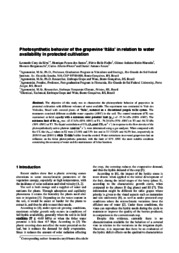Photosynthetic behavior of the grapevine 'Itália' in relation to water availability in protected cultivation.
Photosynthetic behavior of the grapevine 'Itália' in relation to water availability in protected cultivation.
Author(s): SILVA, L. C. da; SANTOS, H. P. dos; FIALHO, F. B.; MARODIN, G. A. B.; BERGAMASCHI, H.; FLORES, C. A.; SOUZA, D. A.
Summary: The objective of this study was to characterize the photosynthetic behavior of grapevines in protected cultivation with different volumes of water available. The experiment was conducted in Vale dos Vinhedos, Brazil with covered plants of ?Italia?, sustained on a discontinued pergola trellis system. The treatments consisted different available water capacity (AWC) in the soil. The control treatment (CT) was maintained at field capacity with a minimum water potential limit (ψm) of -33.34 kPa (100% AWC). The minimum limit of the ψm was -42.12 kPa (83% AWC) at T1, -76.28 kPa (53% AWC) in T2 and -94.32 kPa (30% AWC) at T3. The liquid assimilation of CO2 (A, μmol CO2 m-2 s-1) in response to the flow density of the photosynthetically active photons (μmol m-2 s-1), were determined using a gas analyzer. When compared with the CT, the (Amax) values in T2 were 27,48% and 33% less and in T3 37,92% and 46,5% less, respectively in 2009/10 and 2010/11, while T1 didn?t differ from the control. Water restrictions in covered grapevines had an influence on the foliar photosynthetic potential, with the limit of 83% AWC the most suitable condition considering the economy of water and the maintenance of foliar function.
Publication year: 2014
Types of publication: Paper in annals and proceedings
Unit: Embrapa Grape & Wine
Observation
Some of Embrapa's publications are published as ePub files. To read them, use or download one of the following free software options to your computer or mobile device. Android: Google Play Books; IOS: iBooks; Windows and Linux: Calibre.
Access other publications
Access the Agricultural Research Database (BDPA) to consult Embrapa's full library collection and records.
Visit Embrapa Bookstore to purchase books and other publications sold by Embrapa.

